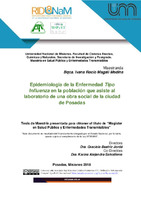Epidemiología de la enfermedad Tipo Influenza en la población que asiste al laboratorio de una obra social de la ciudad de Posadas
Abstract
Las enfermedades de transmisión respiratoria representan un riesgo substancial para la humanidad debido a su elevado potencial de diseminación; por su alta morbi-mortalidad constituyen uno de los problemas de salud pública más importante en todo el mundo. De etiología diversa, la causa más frecuente son los virus como Rinovirus, Influenza A (FLU A) e Influenza B (FLU B), Virus Sincicial Respiratorio (VSR), Adenovirus (ADV), Parainfluenza 1 a 3 (PI).
El objetivo de este trabajo fue identificar y describir la Enfermedad Tipo Influenza (ETI) y la circulación de virus respiratorios en pacientes de todas las edades que concurrieron al Laboratorio del Instituto de Previsión Social de Misiones en el período de Abril de 2015 a Octubre de 2017, inclusive. Se obtuvieron muestras de hisopados y aspirados nasofaríngeos de todos los pacientes que cumplieron con la definición de caso de ETI. La identificación de los agentes etiológicos se realizó mediante Inmunofluorescencia Indirecta (IFI) para la detección de antígenos virales de ADV, FLU A, FLU B, VSR y PI 1-3. Se investigó FLU B y el gen de Hemaglutinina (HA) para subtipificar los virus FLU A mediante RT-PCR convencional.
Si bien la circulación de virus fue diferente en todas las temporadas, en este estudio durante el 2015 predominó FLU B, en 2016 FLU A (H1N1) pdm09 se detectó en la mayoría de los casos, y en el 2017 FLU A, identificándose ambas cepas de FLU A (H1N1) pdm09 y A (H3N2). The diseases of respiratory transmission represent a substantial risk for humanity due to their high dissemination potential; due to their high morbidity and mortality, they are one of the most important public health problems in the world.
Of diverse etiology, the most frequent cause are viruses such as Rhinovirus, Influenza A (FLU A) and Influenza B (FLU B), Respiratory Syncytial Virus (RSV), Adenovirus (ADV), Parainfluenza 1 to 3 (PI).
The objective of this work was to identify and describe the Influenza Type Illness (ETI) and the circulation of respiratory viruses in patients of all ages who attended the Laboratory of the Social Security Institute of Misiones in the period from April 2015 to October 2017, inclusive. Samples of swabs and nasopharyngeal aspirates were obtained from all patients who met the definition of ETI case. The identification of the etiological agents was carried out by Indirect Immunofluorescence (IFI) for the detection of viral antigens of ADV, FLU A, FLU B, RSV and PI 1-3. FLU B and the hemagglutinin (HA) gene were investigated to subtype FLU A viruses by conventional RT-PCR.
While the circulation of viruses was different in all seasons, in this study during 2015 FLU B predominated, in 2016 FLU A (H1N1) pdm09 was detected in most cases, and in 2017 FLU A, identifying both strains of FLU A (H1N1) pdm09 and A (H3N2).
Collections
- Maestría [30]
The following license files are associated with this item:




